Rev Aug 2017.
weldreality Final Home Page.
The
Harley senior management believed their
Harley workers would be "sensitive" to weld criticism.
In
the Harley plant, I sat in a weld team meeting and listened to the discussion on a robot weld spatter
issue on the gas tanks. I was asked by the plant management not to comment on
the weld subjects of the meeting. I found out that the Harley "hands off" engineers and management did not
believe in process ownership. The managers and engineers responsible for the tough image bikes
were afraid of confrontation with their shop floor personnel. They actually believed
the weld shop floor people would be sensitive to constructive criticism of the weld produced.
At the
weld meeting, there were two Harley engineers and six personnel from the shop floor. The discussion was how to resolve a simple robot weld spatter issue on the gas tank. After an hour, this expensive Harley weld
team had not identified the root cause the issue while the reality was the weld spatter solution
required a simple weld voltage adjustment that would have taken less than five minutes
to resolve in the robot cell.
How the Harley management got themselves into a situation in which process ownership were two words they never used, is beyond me. What the Harley management did not understand was their workers were not sensitive to constructive management or engineering criticism,
the worker sensitivity likely came from years of dealing with "hands off" inexperienced managers and engineers that daily revealed it's lack of ownership
and expertise in the weld processes and equipment that they were vital to their manufacturing needs.
Each year, weld issues
cost the welding industry over a billion dollars. The manual and automated weld over costs are generated from less than optimum robot
weld productivity, unnecessary robot down time, wasted man hours from fruitless
weld team meetings, unnecessary weld rejects and rework and in the purchase of useless,
costly, electronic bells and whistles on the MIG equipment.
IF MANAGERS AND ENGINEERS DO THEIR JOB AND PROVIDE THE BEST PRACTICES - PROCESS CONTROL TRAININGTRAINING THEIR EMPLOYEES REQUIRE, MANUFACTURING FACILITIES WOULD NOT REQUIRE A WELD TEAM.
 WELD MANAGEMENT
- ENGINEERS AND THE COMMON GLASS PARTITION. WELD MANAGEMENT
- ENGINEERS AND THE COMMON GLASS PARTITION.
I
have been in over 1000 weld departments in 13 different countries and found too many manufacturing managers
and manufacturing engineers who had placed a "glass partition" between
themselves, the weld personnel or the robots
The glass partition found in plants like Harley GM, Chrysler and Ford, provides the personnel on
the shop floor with the ghostly spirit of management personnel who have no ownership
or physical involvement with the equipment and processes that are vital to their manufacturing needs.
For those managers and engineers that place themselves
behind a glass partition, from my simple perpective you have no right to call your selves engineers or managers as you have created a self imposed isolation from the manufacturing processes that create your corporation's profits.
WHEN MANAGEMENT DOE'S NOT TAKE WELD OWNERSHIP OR PROCESS RESPONSIBILITY, IT SETS ITSELF UP FOR WELD RISKS AND WELD PROCESS LIABILITY CONCERNS
:
 In
a world in which lawyers rub there grubby hands every time a major corporation
has a product issue, it's common in many facilities that use a large amount of
robots to find managers and engineers that will leave the robot MIG weld quality
and productivity in the hands of robot personnel that have not been trained in
MIG weld best practices and lack weld process control expertise. In
a world in which lawyers rub there grubby hands every time a major corporation
has a product issue, it's common in many facilities that use a large amount of
robots to find managers and engineers that will leave the robot MIG weld quality
and productivity in the hands of robot personnel that have not been trained in
MIG weld best practices and lack weld process control expertise.
Car or truck crash? If the
Japanese, European or North American vehicle welded structures or parts were carefully
examined after the crash, it would not take a rocket scientist to figure out that the robot MIG
weld structural integrity, or the resistance welds are not what they were designed to be.
[] It's
common in almost every auto or truck plant to find robot and maintenance personnel daily making "unqualified weld process changes" to the robot welds.
[] It's common in almost every auto or truck plant to find
that the most experienced weld process personnel (typically some bright technician) are held accountable yet are
not given full responsibility for the personnel who influence the robot weld quality
and productivity.
[] It's
common in almost every auto or truck plant to find a lack of awareness for the requirements necessary to attain consistent, optimum weld fusion.
[] It's
common in almost every auto or truck plant to find a lack of uniform best weld
and best manufacturing practices and a complete lack of of weld process controls.
[] It's
common in auto or truck plant to find welded part dimensions that
are not part of the design weld joint tolerances.
[] It's
common in almost every auto or truck plant to find inadequate manual weld repairs for the robot welds and
most of the weld repairs cause more problems than they resolve on the high strength
steels.
 Joe
I have been watching you for the last few months, every time we have a robot weld
issue you bring in a sales rep or one of those guys that represent the robot or
weld equipment manufacturers. Joe
I have been watching you for the last few months, every time we have a robot weld
issue you bring in a sales rep or one of those guys that represent the robot or
weld equipment manufacturers.
if it's affective, I am all for free weld
advice , however from my experience over the last decade, sales
advice is what has got us into this sink hole you call a weld shop. Lets get
past the salesmanship and useless bells and whistles stage. For gods sake take
some weld responsibility and ownership of the equipment and establish some logical, uniform best
weld practices and process controls.
ANY GOOD CORPORATE MANAGER MAY WANT TO EXAMINE
WHY HIS PLANT MANAGEMENT AND ENGINEERS NEEDS OUTSIDE, INEXPERIENCED SALES PERSONNEL TO PROVIDE ADVICE FOR EQUIPMENT AND PROCESSES HIS
COMPANY IS SUPPOSED TO HAVE EXPERTISE IN.
MIG gas confusion makes you pay more the gas mix.
You ask a sales rep for MIIG gas advice
and you expect weld reality?
LIKE CERIAL BOXES IN A SUPERMARKET, THERE
ARE APPROX. 60 GLOBAL MIG GAS MIXES AVAILABLE AND
56 OF THEM ARE SIMPLY NOT REQUIRED.
Weld
Reality: I helped write the AWS MIG Gas Specifications, and for two years at those AWS meetings I struggled and fought to keep the gas sales adjectives out of those specifications. As botha marketing manager and weld trainer for the world's largest gas manufacturers and weld distributors, I also developed and introduced 4 of the top selling MIG gas mixes that are today sold in North America.
Major MIG gas mix producers have a low cost commodity product they attain from the atmosphere. With these companies the MIG gas sales focus is simple, "market share
and profit margin".
To attain their industrial gas profit abd sales goals, most gas companies develop and present a sales game called, "my three part gas mix is better than yours" The gas marketing program is in most cases developed to ensure
a specific MIG gas mix goes from a plain low cost commodity in a steel cylinder to that
of a cylinder with Super Star Status embedded in a weld procedure.
Do you actually believe there is something special
about your over priced three part MIG gas?
Ed
was on the AWS committee that wrote the USA MIG gas specs, and he
developed four
of the most practical MIG gas mixes sold in North America.
For the right gas mix for your company, visit
Ed's MIG gas section for more data.
Salesmanship and three products
the weld industry can live without
The
three welding products that have had the biggest growth in North
American weld
shops during the last decade are:

[1] Three component MIG gas mixes for use on steels.
[2] Metal cored wires for carbon steel welds.
[3] Pulsed MIG equipment for carbon steel welds.
An ironic welding fact: If these three "sales
hyped" weld products disappeared from global weld shops tomorrow, there
would be not be a single negative weld quality - productivity impact for the weld manufacturing industry
with either manual or robot, carbon or stainless steel, weld quality or productivity.
The extensive growth of these three weld products in industrial nations, is a
reflection of the lack of weld process expertise that prevails through out the
global welding industry and an indication of this industry on the reliance of
the weld decision makers on weld sales advice.
 Welcome to the birth place of weld myths,
weld magement
apathy and process ignorance: Welcome to the birth place of weld myths,
weld magement
apathy and process ignorance:
MIG
weld process myths and apathy was born
in the facilities where manual SMAW (stick) or TIG welding were the primary weld processes utilized and the welder's focus
was not on the process or consumables, the focus instead was typically on the "required weld skills" necessary to operate that single weld parameter control on the stick
and TIG process.
MIG weld process myths and management process apathy
also germinated slowly in the high volume manufacturing industries where inexperienced
management and mechanical, maintenance or electrical engineers were daily asked to make weld
process decisions.
TO
CORRECT THE WELDING FUTURE, ONE SHOULD LEARN FROM THE WELDING PAST. AS THE GLOBAL
WELDING PAST WAS GREATLY INFLUENCED BY SALESMANSHIP AND THE WELDING PRESENT IS
ALSO SATURATED WITH EVEN MORE
SALESMANSHIP, I HOPE YOU CAN UNDERSTAND MY FOCUS ON THE
NEGATIVE INFLUENCE OF "WELD SALESMANSHIP".
.jpg) 2006:
MANAGEMENT AND LACK OF WELD PROGRESS: 2006:
MANAGEMENT AND LACK OF WELD PROGRESS:
It
took the majority of structural weld shops, ship yards, chemical plants, pressure
vessel shops and pipeline contractors, more than twenty five years to attain only moderate acceptance of one of the world's most practical and cost effective weld
consumables, the small diameter, 1.2 - 1.4 mm all position, gas shielded flux
cored weld wires.
The small diameter flux cored weld wires were developed
in
the USA by a company called Alloy Rods, now owned by ESAB.
WELD
REALITY. The gas
shielded flux cored wires when welding vertical up or overhead positions, could
deposit in an hour, an amount of weld metal that would take 3 to 5 hours with
stick electrodes. Yet for decades, thanks to management / engineering weld
process apathy, these weld consumables were a difficult sell in ship yards, the oil
/ power industry, refineries and facilities that weld pressure vessels and pipes. If you weld pipe today you need to see the world's best pipe weld process. Please take a look www.tiptigusa.com for your next pipe job or if you are welding any alloy applications.
FUNDAMENTAL FCA WELD
COST QUESTION: An 0.045 (1.2mm) E71T-1 flux cored wire is used for
manual welding a common 6 mm vertical up structural steel fillet weld. The 0.045 wire feed
is set at an optimum wire feed setting of 280 ipm (11 o'clock on many wire feed controls). Your job has something to do with controlling the weld costs. How many pounds per/hr will the welder
use if his arc on time is 30 min/hr? If the application requires 200 feet of this
weld how long will it take to complete the welds?
FUNDAMENTAL MIG WELD
COST QUESTION: An 0.045 MIG wire is used to weld a 3/16 fillet weld with
a robot. The wire feed is set at 350 ipm. What is the weld deposition rate? What
will be the weld travel rate? On a small steel part three welds 4 inch long
(10 cm ) are required, what will be the robot weld cycle time?
If
you are in the weld industry and required more than 5 minutes to answer these two fundamental weld process
cost questions, you know something is not right. Please consider my " Management and Engineers Guide to MIG"
book or any of my MIG / FCAW process control, CD, training resources. These materials will
simplify weld costs and process controls.
Typically
when a weld process change is considered, many managers and engineers will seek
advice from a salesmen or a tech rep who is recent college graduate with a degree
in art or civil engineering.
When the switch to the MIG or flux cored process
occurres in the shop, in too many instances the welders wiill be seen to play around
with the weld controls which simply points out the welders were not provided with the best weld practices and process controls that are necessary to optimize the weld performance from the new process or consumables utilized .
The bottom line, no matter how sophisticated a company believes it's weld shop to be, if the persons who do the welds and the persons who make the weld decisions, don't know optimum weld practices and weld settings the weld shop will never reach it's weld quality and productivity potential.
 FLUX CORED: When all position, code quality welds are required, the gas shielded flux cored process will never be able to compete with the TIP TIG process. (www.tiptigusa.com.) However in contrast to SMAW and the pulsed MIG process, the
four primary weld process benefits attained from gas shielded flux cored welds wires are, FLUX CORED: When all position, code quality welds are required, the gas shielded flux cored process will never be able to compete with the TIP TIG process. (www.tiptigusa.com.) However in contrast to SMAW and the pulsed MIG process, the
four primary weld process benefits attained from gas shielded flux cored welds wires are,
[1] all position welds, easier to use,
[2] all position welds,
higher deposition rates,
[3] all position welds, superior weld fusion.
[4]
the ability to add alloys to the flux to meet specific mechanical properties.
With the above benefits, it's reasonable to ask why it took the majority of pipe - vessel weld shops twenty to thirty years before they changed from the SMAW process to flux cored.
The excess salesmanship
influence and the prevalent lack of MIG and flux cored weld process control expertise has created
the global "play around industry". With this in mind when the MIG process is selected today,
many companies will consider purchasing;
[1]
Unnecessary, costly, pulsed MIG equipment for steel welds, or STT - RMD and Inverter MIG equipment.
[2] Useless,
higher cost, carbon steel Metal Cored wires or gas shielded flux cored wires when lower cost MIG wires were fine. Over sized MIG wires for the applications. And you know a company is at the bottom of the barrel when it selects self shielded
flux cored wires for its applications.
[3] Expensive and completely ineffective three part
gas mixes, and coming your way soon, useless four part gas mixes.
MANAGEMENT
- ENGINEERING APATHY
HAS FOR DECADES
INFLUENCED THE WELD SHOP CULTURE AND TWO COMMON WORDS ARE WHY CHANGE?
2013: If
a nuclear plant or chemical plant needs construction, or requires major equipment rebuild or
repairs, too often out comes the original design prints along with the original
weld process recommendations from 1973. It may be four decades later,
but in 2013, the sad reality is the engineering company responsible for the contract will typically
lack the weld process confidence necessary to evalute alternative weld processes and consumables..
DON'T
ASK WELD PROCESS CONTROL QUESTIONS IN YOUR PLANT:
If
I visited ten plants that use either the common E71T-1, 0.045 - 0.052 (1.2 -
1.4 mm) gas shielded flux cored wires and ask the key weld personnel to provide the optimum, narrow, weld
voltage, wire feed and weld deposition range for welding a common vertical up, 1/4, (6
mm) fillet, I would expect 10 very different answers. And if I asked any weld shop supervisor what the 045 flux cored wire deposition rate was with the wire set at 250 inch/min, I would expect nothing.
The
bottom line. More than three decades have passed since the all position flux cored
wire introduction, yet today, few weld personnel in the industrial world have
been taught the optimum, flux cored wire feed, amp range and volt settings. To view a great flux cored best practises - process control training program.
 In
the time period from 1985 to 2005, lack
of fundamental weld process expertise was the prime reason for the extraordinary slow
growth of the highly cost effective, gas shielded flux cored weld wires.
In
the time period from 1985 to 2005, lack
of fundamental weld process expertise was the prime reason for the extraordinary slow
growth of the highly cost effective, gas shielded flux cored weld wires.
|
Any manager - supervisor, engineer or technician looking to resolve weld issues,
has to first recognize the relevance of a subject rarely discussed in weld shops, it's called "Weld Process Control Expertise".
In
the last decade, as many weld shops aggressively evolved from manual to robot MIG
welding, the subject of "weld process control expertise" was rarely given consideration by the management. Need evidence? Just look at
weld engineers job posting on the web. In many instances you are likely to see that the company
hiring the "weld engineer" wants a weld engineer with paint
shop and press
shop expertise rather than an individual with "MIG weld process control
expertise". By the way take a look at your own job description and see how much relevance is placed on Best Weld Practices and Weld Process Control experience.
 THE INEXPERIENCED HR DEPARTMENT MANAGER IS LOOKING FOR A MULTI-TALENTED ENGINEER OR TECHNICIAN? THE INEXPERIENCED HR DEPARTMENT MANAGER IS LOOKING FOR A MULTI-TALENTED ENGINEER OR TECHNICIAN?
To be
an expert in the paint shop, press shop, tool room and weld shop, would require another Morman miracle and one of those was enough. The bottom line is each of these
trades would take a life time to master. Yet how many times do you see jobs
listed on the web in which the company management and HR has asked for someone who has expertise
in all.
This general lack of management understanding of the process expertise
requirements for the implementation of process controls is one of the prime reasons
manufacturing facilities do not get control of their processes. Most of the individuals
who are in charge of robot lines typically lack "best weld practices - process control
expertise"
 BEAN
COUNTERS WILL BE PLEASED TO KNOW THAT WHEN IT COMES TO RESOLVING MOST ROBOT OR MANUAL WELDING ISSUES, THAT MONEY IS RARELY THE ANSWER. BEAN
COUNTERS WILL BE PLEASED TO KNOW THAT WHEN IT COMES TO RESOLVING MOST ROBOT OR MANUAL WELDING ISSUES, THAT MONEY IS RARELY THE ANSWER.
 With
a poorly understood MIG process married to a robot, many managers
and engineers are under the impression that the costly, six axis robots combined with the
most expensive pulsed MIG power source would be the solution to their daily, aggravating
manual MIG weld issues. After all, with this sophisticated automated equipment, they would no longer have
welders who play around with the weld controls. The management and engineering
logic in many plants, is the more you
spend in the robot cell, the more you should
be able
to cut through the weld shop process issues and attain consistent weld
quality and productivity. The reality is now they have robot personnel that are likely playing around with the weld controls. With
a poorly understood MIG process married to a robot, many managers
and engineers are under the impression that the costly, six axis robots combined with the
most expensive pulsed MIG power source would be the solution to their daily, aggravating
manual MIG weld issues. After all, with this sophisticated automated equipment, they would no longer have
welders who play around with the weld controls. The management and engineering
logic in many plants, is the more you
spend in the robot cell, the more you should
be able
to cut through the weld shop process issues and attain consistent weld
quality and productivity. The reality is now they have robot personnel that are likely playing around with the weld controls.
 2007: DUE TO THE COMMON AUTOMOTIVE MANAGEMENT
INCORRECT ASSUMPTION, THAT IN GENERAL SKILLED WELDERS HAVE AN UNDERSTANDING OF WELD PROCESS CONTROL
DATA, FEW COMPANIES IN THE INDUSTRIAL WORLD HAVE EVER ALLOCATED FUNDS FOR "ROBOT
MIG WELD PROCESS CONTROL TRAINING". 2007: DUE TO THE COMMON AUTOMOTIVE MANAGEMENT
INCORRECT ASSUMPTION, THAT IN GENERAL SKILLED WELDERS HAVE AN UNDERSTANDING OF WELD PROCESS CONTROL
DATA, FEW COMPANIES IN THE INDUSTRIAL WORLD HAVE EVER ALLOCATED FUNDS FOR "ROBOT
MIG WELD PROCESS CONTROL TRAINING".
When
companies purchase robots, training funds are typically provided for the robot
personnel to learn about "robot programming". In contrast, funds are rarely provided to teach the employees weld best practices - process control data necessary
for robot weld optimization. The bottom line is this is not likely to happen till management has the ability to recognize
the importance of the subject, then they would readily providing the training budget, (if they could find the qualified trainers).
This
Management and Engineers Guide to MIG and flux cored book was written by Ed for managers,
designers, engineers, QA personnel and robot and weld technicians.
With
600 pages, this book is
the most comprehensive, honest , practical book ever written on the subject of
MIG and flux cored weld process controls.
For
managers, designers, engineers and robot technicians, this is the book you need
to understand the requirements of both manual - robot weld process controls.
Ed
has also written three MIG process control books, and developed unique manual - robot MIG and flux
cored best practices - process control, CD power point, self teaching and training resources. These require no expertise to present.
Click here.
To contact Ed send an E-MAIL to ecraig@weldreality.com
or
phone 828 337 2695
|
 From
robot MIG welds on Ford, GM, Chrysler, Mercedes, Volvo, Honda, VW, Toyota auto
/ truck, parts, to welding Harley or Indian bike parts or using robots and automated
equipment to weld pipe, boiler components, ships, trains nuclear parts and kitchen
sinks, after 50 years it's hard today for me to work on a "new weld
application". From
robot MIG welds on Ford, GM, Chrysler, Mercedes, Volvo, Honda, VW, Toyota auto
/ truck, parts, to welding Harley or Indian bike parts or using robots and automated
equipment to weld pipe, boiler components, ships, trains nuclear parts and kitchen
sinks, after 50 years it's hard today for me to work on a "new weld
application".
Irrespective
of the complexity of the welded application, this writer set robot welds on some
of the world's most complex and diversified applications. In setting a robot weld
I have never "played around" with the weld data. I never required sophisticated
weld equipment or three part gas mixes and I found that all the multinational robots were always more
than capable of meeting any welding challenge. Of course some Japanese robots
like Panasonic and Motoman made my welding life more complex than it needed to be, and many
of the Japanese designed pulsed MIG equipment that's used for steel welds should
never have left the land of the "setting" sun.
THE
SAD MANAGEMENT IN THE AUTO AND TRUCK INDUSTRY, THAT TAKE THE INEFFECTIVE "MAINTENANCE
APPROACH" TO PROVIDING ROBOT MIG WELD PROCESS CONTROLS.
 Joe
every time I walk past the robot cells, someone from the maintenance department
is screwing around with the robot weld data. Come on Joe, do you actually believe
the maintenance millwrights or electricians have the MIG weld process control
expertise necessary to optimize robot MIG welds, when our weld personnel and engineers
have shown they can't handle the weld problems. What planet did you say you were
from? Joe
every time I walk past the robot cells, someone from the maintenance department
is screwing around with the robot weld data. Come on Joe, do you actually believe
the maintenance millwrights or electricians have the MIG weld process control
expertise necessary to optimize robot MIG welds, when our weld personnel and engineers
have shown they can't handle the weld problems. What planet did you say you were
from?
The real solution for an effective robot weld process control team
is for the manufacturing manager to ensure that weld process control training
is provided for all members of the weld team even if they are maintainence perssonel.
What
is robot weld
process expertise?
 * Robot weld process expertise
is the ability of the programmer to instantly set any weld application with optimum parameters without
"reference to a book" without asking a salesman, and without "playing
around" with the MIG or flux cored weld controls. * Robot weld process expertise
is the ability of the programmer to instantly set any weld application with optimum parameters without
"reference to a book" without asking a salesman, and without "playing
around" with the MIG or flux cored weld controls.
* Robot
weld process expertise is the ability without the aid of a salesman,
to choose optimum weld consumables and be instantly aware of optimum weld
parameters required for those consumables and the application.
* Robot weld process expertise is the ability to set each welds at the highest weld deposition rates while also attaining optimum weld quality.
* Robot weld process expertise is
the ability of the weld decision maker to differentiate between practical
robot and weld equipment from costly useless bells and whistles and purchase robot and weld equipment that is practical, durable and
easy to use.
*
Robot weld process expertise is the ability to know the unique
process differences between manual and robot MIG welds and ensure the unique technique
and parameter requirements are part of the robot's program.
 * Robot
weld process expertise is the ability to advise designers on how they can enhance
their design to ensure the process selected will reach it's full productivity potential
and provide optimum weld quality. * Robot
weld process expertise is the ability to advise designers on how they can enhance
their design to ensure the process selected will reach it's full productivity potential
and provide optimum weld quality.
* Robot weld process expertise
is the ability to advice fixture manufactures with information that will
enhance the fixture design to enable optimum weld quality and productivity from
the welding operation..
* Robot weld process expertise is
the ability to train operators on what to do and what not to do in the
robot cell.
*
Robot weld process expertise is the ability to instantly change
from a short circuit, globular, spray or pulsed weld and set optimum weld parameters.
* Robot weld process
expertise is the ability to set up robot weld process controls that will
ensure the weld reject rate is never more than 2%.
*
Robot weld process expertise is the ability to ensure that the
maximum robot down time per shift is never more than 20 minutes.
* Robot
weld process expertise is the ability to know that the robot production
efficiency is always optimum.
 * Robot
weld process expertise is the ability to work out the cost of a weld
in less than 2 minutes. * Robot
weld process expertise is the ability to work out the cost of a weld
in less than 2 minutes.
* Robot weld process expertise is
the ability to establish a robot weld process control program for each application.
A program that will ensure daily consistency in the weld quality and productivity.
* Robot weld process expertise is the ability to set up
an effective robot PM program for each robot cell.
 Frustrated
managers in an attempt to grasp and control something, may focus the plant personnel
on the bottomless, paper bureaucracy required for the ever expanding, European
driven, ISO specifications. Of course once the ISO audit has been wrapped up and
the weld reject bins are still full, the plant's engineering resources can then
directed at the latest manufacturing method from Japan. It's a wonder Henry Ford
does not rise from the dead. Frustrated
managers in an attempt to grasp and control something, may focus the plant personnel
on the bottomless, paper bureaucracy required for the ever expanding, European
driven, ISO specifications. Of course once the ISO audit has been wrapped up and
the weld reject bins are still full, the plant's engineering resources can then
directed at the latest manufacturing method from Japan. It's a wonder Henry Ford
does not rise from the dead.
You may know a plant manager
that suffers daily from robot weld process issues, yet with the change of the
season, will immerse his plant in the latest, manufacturing practice.
TOPS.
- DOE. - FMEA. - KAIZEN. - KANBAN. - MRP. - JIT. - Q.M. - SPC. POKE. - YOKE, and
coming soon from Japan the latest lean method called "JOKE"
 Joe
this is America, we don't need European bureaucracy or the Japanese practices to tell us how to weld two pieces of steel together. Joe
this is America, we don't need European bureaucracy or the Japanese practices to tell us how to weld two pieces of steel together.
Joe I
don't believe we have one individual in this organization who has the ability to establish Best Weld
Practices or implement Weld Process Controls, yet we have 5 engineers with black
belts and a QA department with a three million dollar budget. And Joe, don't get
me going on your latest lean manufacturing method. For gods sake, how many colored
belts, QA personnel or Japanese and European manufacturing methods and specifications
does this company need to;
[a] take the steel in the East door,
[b]
clean it,
[c] cut it,
[d] form it,
[e] fixture it,
[f] weld
it,
[g] build it,
[h] test it,
[i] paint it,
[j] and then ship
the bloody products out of the West door?
There
are too many weld manufacturing decision makers that unfortunately see themselves
in the roll of the frustrated company fire fighter, "forever
fighting, but never quenching the weld production and weld quality issues".
There
are two fundamental requirements for quenching weld shop fires and resolving robot
or manual welding issues.
 [1]
Managers,
engineers and supervisors have to recognize
the importance of "weld process control expertise" Managers be aware that the
weld supervisor with his thirty years of stick welding back ground typically has
no idea what the optimum MIG wire feed rate is with an 0.045 1.2mm wire welding
a 3/16 4.8 mm fillet. [1]
Managers,
engineers and supervisors have to recognize
the importance of "weld process control expertise" Managers be aware that the
weld supervisor with his thirty years of stick welding back ground typically has
no idea what the optimum MIG wire feed rate is with an 0.045 1.2mm wire welding
a 3/16 4.8 mm fillet.
[2] Managers ensure all the relevant weld decision makers in the shop receive
the necessary best practice and weld process control training.
[3] Managers, engineers and supervisors recognize the
importance and 7 step fundamental requirements necessay to implement effective "robot weld process controls"
. Managers follow up weekly on the status of of the plant's weld process control
and RPM programs.
The following is an example of what
weld process best practices
and
process controls expertise can achieve.
 General
Motors installed a new multi-million dollar, torque converter, automated MIG welding line
at one of it's Midwest manufacturing facilities. General
Motors installed a new multi-million dollar, torque converter, automated MIG welding line
at one of it's Midwest manufacturing facilities.
After
the line integrator had built and installed the torque converter welding lines,
I was asked by the GM engineer responsible to address the automated, pulsed MIG
weld quality issues which were being caused by the new Lincoln, PowerWave pulsed MIG equipment.
 In
less than 16 hours at the plant, I switched the inconsistent pulsed mode off,
and established more effective, traditional MIG spray transfer weld parameters
for the torque converter welds. In
less than 16 hours at the plant, I switched the inconsistent pulsed mode off,
and established more effective, traditional MIG spray transfer weld parameters
for the torque converter welds.
The torque line produced almost a 1000 parts a day. The new weld procedures I generated
along with the weld process controls that I implemented, changed the daily weld
reject rate from five - eigtht percent down to "zero" percent.
As a bonus to GM, I also increased the daily mechanized weld production by twenty
percent.
Note: The optimum weld results that I attained at the
GM plant could have been achieved with traditional MIG equipment that would have
cost GM seventy percent less.
The
weld process changes for the GM torque converters, saved GM millions annually in weld rework elimination and weld productivity improvements.
I recieved a check from GM for less than $3000.
It was interesting while I was their that the management and engineers showed little interest in what I was doing.
The weld shop, BS, artists, smoke & mirrors:
 I
have come across many managers and engineers who believe that MIG welding is a
"skilled art form", a process blanketed
by smoke and sparks, a process set by weld personnel who
often have to play around with the weld controls. The weld reality is of
course the opposite. I
have come across many managers and engineers who believe that MIG welding is a
"skilled art form", a process blanketed
by smoke and sparks, a process set by weld personnel who
often have to play around with the weld controls. The weld reality is of
course the opposite.
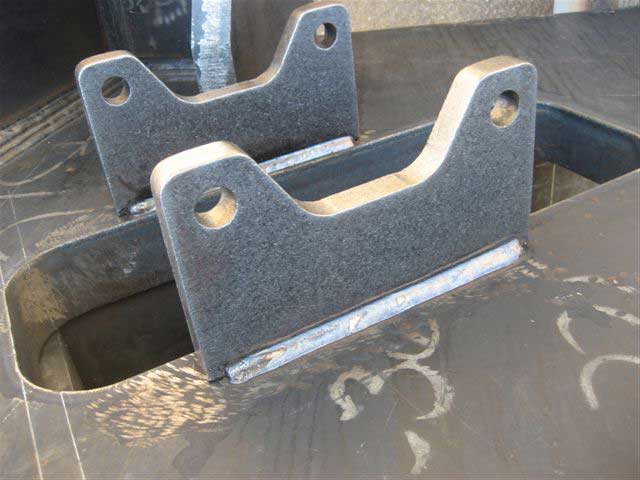 Examine a repeatable, quality robot MIG weld on
a part with consistent fit
tolerance. Examine a repeatable, quality robot MIG weld on
a part with consistent fit
tolerance.
This optimum, robot MIG fillet weld is made by a low cost CV
machine, an 045 wire and simple 15% argon CO2 gas mix, The spatter free untouched weld was made by a dumb blind robot that does not have an artistic bent in it's rigid, six axis, metal body.
As to be expected, Joe got fired. The
next manufacturing manager 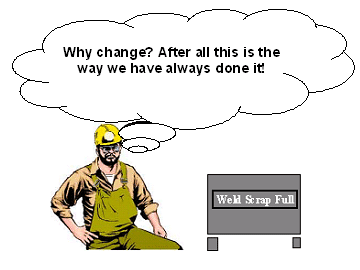
will have to create change. And we all know change does not come easy to
an industry that is known for it's reliance on salesmanship and it's blinkered
approach to best weld practices and process controls.
Change
is always difficult to implement in an industry steeped in biased, product sales
hype and immersed in numerous weld process myths.
Change
in a weld shop will always be hindered by individuals who lack process expertise,
lack process confidence and have attained a comfort level with their daily, this
is the way we have always done it welding mediocrity.
Change is always
difficult in a self taught industry where egos, thick skin and process ignorance
often hinder the path to weld quality and production potential.
Positive
change in a weld shop should come from practical, constructive criticism, based
on sound weld process principles.
I
hope this site is delivering a little of what you need.
Weld
Education: With
MIG welding responsible for more than seventy five  percent
of the welds produced daily, it's a sad weld reality that in North America, Japan
and Europe, that the majority of universities or colleges that teach weld engineers and technicians,
don't teach their students how to implement effective MIG weld process
controls. percent
of the welds produced daily, it's a sad weld reality that in North America, Japan
and Europe, that the majority of universities or colleges that teach weld engineers and technicians,
don't teach their students how to implement effective MIG weld process
controls.
Please remember, the purpose of this site is not to bash engineers
or managers, the purpose
is to get juices flowing and create positive change in an entrenched, stagnant
industry. To create change, first requires a determination of of the common root
cause issues and constructive resolutions. For those that are upset by my comments,
you need thicker skin or perhaps you are in the wrong profession.
Weld
Equipment & Electronic Madness.
Extensive
weld equipment data is
available in the MIG section of this site.
 Electronics for weld equipment manufacturers was the goose that laid the golden eggs. While
sophisticated electronics can provide huge benefits in manufacturing equipment,
one should remember that there are certain tools, equipment and processes that
simply do not need electronic circuit boards. Electronics for weld equipment manufacturers was the goose that laid the golden eggs. While
sophisticated electronics can provide huge benefits in manufacturing equipment,
one should remember that there are certain tools, equipment and processes that
simply do not need electronic circuit boards.
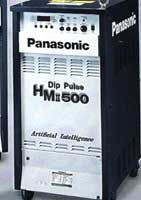 The people who typically attain the greatest benefits from the power source
electronics used in the MIG equipment that welds carbon steels, are the
MIG power
source manufacturers and distributors who sell the equipment. The people who typically attain the greatest benefits from the power source
electronics used in the MIG equipment that welds carbon steels, are the
MIG power
source manufacturers and distributors who sell the equipment.
During
the last decade, MIG power source manufactures have found a
home for electronic
chips and printed boards. These companies quickly found out that with "electronics",
they could triple the cost of their MIG equipment.
You can pay $2000 or $12000 for a MIG power source and on steel welds you will
not attain benefits that impact the bottom line from the $12000 power source.
The high cost of electronic MIG equipment strikes me as strange, as the implementation
of electronics into most other manufacturing products has typically ended up lowering
the cost of the products.
UNNECESSARY MIG POWER SOURCE COMPLEXITY.
Panasonic proudly informs the welding public. "To
cover all weld application possibilities, our Panasonic MIG equipment has a data
base of "four million patterns" of various weld wave forms". It's
ironic that in the two decades of costly pulsed equipment evolution, I have yet
to see one pulsed MIG power sources out perform the traditional lower cost, more
rugged CV, MIG equipment on a steel weld. By the way every MIG weld application
in the world only requires 4 weld settings from a specific weld transfer mode,
so I don't know why Panasonic needs the other 3,999,996 wave forms.
Manual Weld Reality Statement:
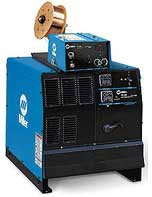 When
using MIG or flux cored wires. Optimum quality, spatter free
carbon steel and stainless welds made in all positions, can be made at the highest
possible weld speeds and deposition rates, with traditional, low cost, $2000 -
$3000 none electronic, CV MIG equipment. When
using MIG or flux cored wires. Optimum quality, spatter free
carbon steel and stainless welds made in all positions, can be made at the highest
possible weld speeds and deposition rates, with traditional, low cost, $2000 -
$3000 none electronic, CV MIG equipment.
All
it takes for optimum MIG welds on more than 99% of the world's steel and stainless
applications, is a traditional well made 300 - 400 amp, CV power source, a two
part argon / CO2 mix, a MIG
wire, four wire feed and four volt settings, some skill and the "process
and technique expertise" available in my CDs and books.
Remember
this is the weld industry. Please don't get pissed off at the messanger, Lets face it, you should not be in this industry if you don't have thick skin and a wicked sense of humor.
| |